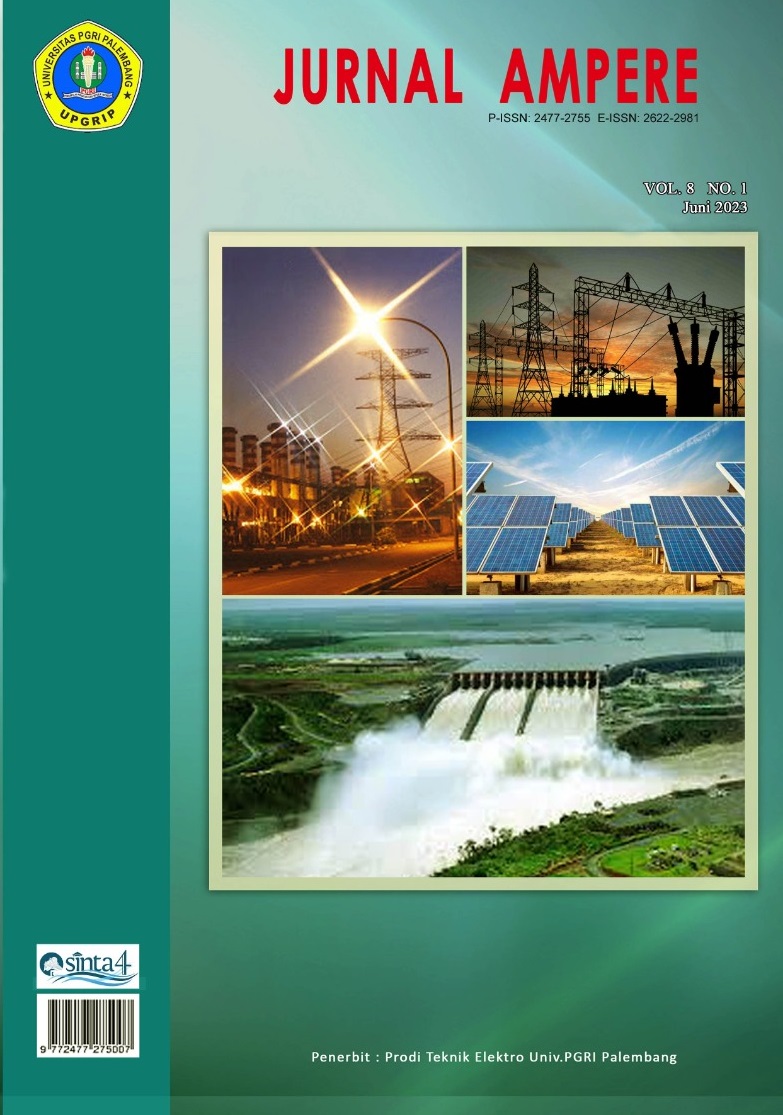Analisis Kinerja PLTS 200WP Secara Realtime Menggunakan IoT
DOI:
https://doi.org/10.31851/ampere.v8i1.12300Keywords:
Solar Cell, Performansi PLTS, NodeMCU ESP8266, Intenet ofThings, BlynkAbstract
Technological developments occur in various ways, for example wireless communication technology, computer networks and the internet, designing monitoring and control systems based on the Internet of Things (IoT). The application of the IoT concept has been widely carried out with various studies in various fields of life including analyzing solar panels in real time which can be done by utilizing the development of micro and wireless and internet-based control technology called IoT. The performance of a PLTS can be assessed by calculating the efficiency of the PLTS components themselves. The purpose of this study is to analyze the performance of a 200Wp PLTS from IoT-based Blynk application data. The methodology used in this study starts from 1) tool design; 2) tool making; 3) tool testing; 4) evaluation. From the results of the study it was found that the efficiency of solar panels was 11.35% The efficiency of SCC was 93%, the efficiency of Baerai was 94.8%, the efficiency of inverters was 92.6%, and the total efficiency of PLTS was 9.29% . The efficiency of this PLTS is considered low for a 200Wp PLTS
References
A. R. Dewananta, R. A. Rahmadhani, D. Maulana, G. Setyono, and M. Muharom, “RANCANG BANGUN ROMBONG LISTRIK DENGAN MENGGUNAKAN PEMBANGKIT LISTRIK TENAGA SURYA ( PLTS ) KAPASITAS 200 WATT,” vol. 01, no. 01, pp. 1–6, 2022.
S. Sofiah and Y. Apriani, “Pengaturan Kecepatan Motor Ac Sebagai Aerator Untuk Budidaya Tambak Udang Dengan Menggunakan Solar Cell,” J. Ampere, vol. 4, no. 1, p. 209, 2020, doi: 10.31851/ampere.v4i1.2825.
Z. Taro and Hamdani, “Analisis Biaya Pembangkit Listrik Tenaga Surya (PLTS) Atap Skala Rumah Tangga,” Jesce, vol. 3, no. 2, pp. 65–71, 2020.
A. F. Farizy and D. A. Asfani, “Desain Sistem Monitoring State Of Charge Baterai Pada Charging Station Mobil Listrik Berbasis Fuzzy Logic Dengan Mempertimbangkan Temperature,” J. Tek. ITS, vol. 5, no. 2, 2016, doi: 10.12962/j23373539.v5i2.16203.
A. STEFANIE and F. C. SUCI, “Analisis Performansi PLTS Off-Grid 600 Wp menggunakan Data Akuisisi berbasis Internet of Things,” ELKOMIKA J. Tek. Energi Elektr. Tek. Telekomun. Tek. Elektron., vol. 9, no. 4, p. 761, 2021, doi: 10.26760/elkomika.v9i4.761.
R. Hasrul, “Sistem Pendinginan Aktif Versus Pasif Di Meningkatkan Output Panel Surya,” J. Sain, Energi, Teknol. Ind., vol. 5, no. 2, pp. 79–87, 2021.
F. Supegina and T. Elektro, “Rancang Bangun Iot Temperature Controller Untuk Enclosure Bts Berbasis Microcontroller Wemos Dan Android Issn : 2086 ‐ 9479,” J. Teknol. Elektro, Univ. Mercu Buana, vol. 8, no. 2, pp. 145–150, 2017.
M. Istiyo Winarno, “Implementasi Maximum Power Point Tracker ( Mppt ) Untuk Optimasi Daya Pada Panel Surya Berbasis,” Semin. Nas. Teknol. Inf. dan Multimed. 2018, pp. 49–54, 2018.
Downloads
Published
How to Cite
Issue
Section
License
Copyright (c) 2023 Yosi Apriani, Muhammad Alfarizi, Zulkifli Saleh, Wiwin A Oktaviani, Krisna Nata Wijaya

This work is licensed under a Creative Commons Attribution-ShareAlike 4.0 International License.

Jurnal Ampere is licensed under a Creative Commons Attribution-ShareAlike 4.0 International License.
Authors who publish with this journal agree to the following terms:
- Authors retain copyright and grant the journal right of first publication with the work simultaneously licensed under a Creative Commons Attribution License that allows others to share the work with an acknowledgement of the work's authorship and initial publication in this journal.
- Authors are able to enter into separate, additional contractual arrangements for the non-exclusive distribution of the journal's published version of the work (e.g., post it to an institutional repository or publish it in a book), with an acknowledgement of its initial publication in this journal.
- Authors are permitted and encouraged to post their work online (e.g., in institutional repositories or on their website) prior to and during the submission process, as it can lead to productive exchanges, as well as earlier and greater citation of published work.






